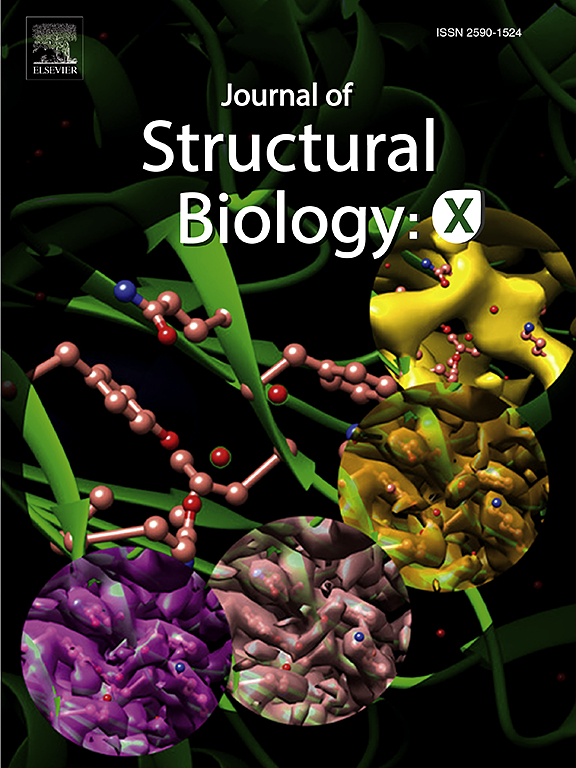Effects of Gα C-terminal deletion on the intrinsic GDP release/GTPase activity and conformational dynamics
IF 2.7
3区 生物学
Q3 BIOCHEMISTRY & MOLECULAR BIOLOGY
引用次数: 0
Abstract
Heterotrimeric G proteins (G proteins) serve as key signaling mediators downstream of G protein-coupled receptors (GPCRs). Comprised of Gα, Gβ, and Gγ subunits, the activation state of Gα, determined by GDP or GTP binding, governs G protein activity. While high-resolution structures of GPCR-G protein complexes have identified the Gα C-terminal 5 residues (i.e., wavy hook) as critical for GPCR binding and coupling selectivity, its influence on Gα’s intrinsic biochemical properties remains unclear. Here, we investigated the role of wavy hook truncation in the intrinsic GDP/GTP turnover rate, GTPase activity, and conformational dynamics of Gαs and Gαi1 using BODIPY-labeled nucleotides and hydrogen/deuterium exchange mass spectrometry (HDX-MS). Truncation of the wavy hook significantly altered the GDP/GTP turnover rate, GTPase activity, and conformational flexibility of Gαs, particularly at the p-loop through α1 region, but had minimal impact on Gαi1. These findings reveal subtype-specific effects of the wavy hook on G protein stability and conformational dynamics, highlighting the importance of structural elements in regulating G protein function and their implications for GPCR signaling studies.

Gα C 端缺失对固有 GDP 释放/GTP 酶活性和构象动态的影响
异三聚体G蛋白(G蛋白)是G蛋白偶联受体(gpcr)下游的关键信号介质。由Gα、Gβ和Gγ亚基组成,Gα的激活状态由GDP或GTP结合决定,控制着G蛋白的活性。虽然GPCR- g蛋白复合物的高分辨率结构已经确定了Gα c端5残基(即波浪钩)是GPCR结合和偶联选择性的关键,但其对Gα内在生化特性的影响尚不清楚。本研究利用bodipy标记的核苷酸和氢/氘交换质谱(HDX-MS)研究了波浪钩截断在Gαs和Gαi1的内在GDP/GTP周转率、GTP酶活性和构象动力学中的作用。波浪钩的截断显著改变了g - αs的GDP/GTP周转率、GTP酶活性和构象柔韧性,特别是在p环穿过α1区域,但对g - α1的影响很小。这些发现揭示了波浪钩对G蛋白稳定性和构象动力学的亚型特异性影响,突出了结构元件在调节G蛋白功能中的重要性及其对GPCR信号传导研究的意义。
本文章由计算机程序翻译,如有差异,请以英文原文为准。
求助全文
约1分钟内获得全文
求助全文
来源期刊

Journal of structural biology
生物-生化与分子生物学
CiteScore
6.30
自引率
3.30%
发文量
88
审稿时长
65 days
期刊介绍:
Journal of Structural Biology (JSB) has an open access mirror journal, the Journal of Structural Biology: X (JSBX), sharing the same aims and scope, editorial team, submission system and rigorous peer review. Since both journals share the same editorial system, you may submit your manuscript via either journal homepage. You will be prompted during submission (and revision) to choose in which to publish your article. The editors and reviewers are not aware of the choice you made until the article has been published online. JSB and JSBX publish papers dealing with the structural analysis of living material at every level of organization by all methods that lead to an understanding of biological function in terms of molecular and supermolecular structure.
Techniques covered include:
• Light microscopy including confocal microscopy
• All types of electron microscopy
• X-ray diffraction
• Nuclear magnetic resonance
• Scanning force microscopy, scanning probe microscopy, and tunneling microscopy
• Digital image processing
• Computational insights into structure
 求助内容:
求助内容: 应助结果提醒方式:
应助结果提醒方式:


